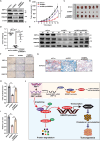Unspliced XBP1 contributes to cholesterol biosynthesis and tumorigenesis by stabilizing SREBP2 in hepatocellular carcinoma
- PMID: 35933495
- PMCID: PMC11073046
- DOI: 10.1007/s00018-022-04504-x
Unspliced XBP1 contributes to cholesterol biosynthesis and tumorigenesis by stabilizing SREBP2 in hepatocellular carcinoma
Abstract
Cholesterol biosynthesis plays a critical role in rapidly proliferating tumor cells. X-box binding protein 1 (XBP1), which was first characterized as a basic leucine zipper-type transcription factor, exists in an unspliced (XBP1-u) and spliced (XBP1-s) form. Recent studies showed that unspliced XBP1 (XBP1-u) has unique biological functions independent from XBP1-s and could promote tumorigenesis; however, whether it is involved in tumor metabolic reprogramming remains unknown. Herein, we found that XBP1-u promotes tumor growth by enhancing cholesterol biosynthesis in hepatocellular carcinoma (HCC) cells. Specifically, XBP1-u colocalizes with sterol regulatory element-binding protein 2 (SREBP2) and inhibits its ubiquitination/proteasomal degradation. The ensuing stabilization of SREBP2 activates the transcription of 3-hydroxy-3-methylglutaryl-CoA reductase (HMGCR), a rate-limiting enzyme in cholesterol biosynthesis. We subsequently show that the XBP1-u/SREBP2/HMGCR axis is crucial for enhancing cholesterol biosynthesis and lipid accumulation as well as tumorigenesis in HCC cells. Taken together, these findings reveal a novel function of XBP1-u in promoting tumorigenesis through increased cholesterol biosynthesis in hepatocarcinoma cells. Hence, XBP1-u might be a potential target for anti-tumor therapeutic strategies that focus on cholesterol metabolism in HCC.
Keywords: Cholesterol biosynthesis; SREBP2; Tumorigenesis; Unspliced XBP1 (XBP1-u); XBP1.
© 2022. The Author(s), under exclusive licence to Springer Nature Switzerland AG.
Conflict of interest statement
The authors declare no potential conflicts of interest.
Figures








Similar articles
-
PBX3-HMGCR Axis Promotes Hepatocellular Carcinoma Progression Through Enhancing De Novo Cholesterol Biosynthesis.Int J Mol Sci. 2025 May 29;26(11):5210. doi: 10.3390/ijms26115210. Int J Mol Sci. 2025. PMID: 40508020 Free PMC article.
-
Cholesterol biosynthesis supports the growth of hepatocarcinoma lesions depleted of fatty acid synthase in mice and humans.Gut. 2020 Jan;69(1):177-186. doi: 10.1136/gutjnl-2018-317581. Epub 2019 Apr 6. Gut. 2020. PMID: 30954949 Free PMC article.
-
Caspase-3-Induced Activation of SREBP2 Drives Drug Resistance via Promotion of Cholesterol Biosynthesis in Hepatocellular Carcinoma.Cancer Res. 2022 Sep 2;82(17):3102-3115. doi: 10.1158/0008-5472.CAN-21-2934. Cancer Res. 2022. PMID: 35767704
-
Spliced or Unspliced, That Is the Question: The Biological Roles of XBP1 Isoforms in Pathophysiology.Int J Mol Sci. 2022 Mar 2;23(5):2746. doi: 10.3390/ijms23052746. Int J Mol Sci. 2022. PMID: 35269888 Free PMC article. Review.
-
XBP1 as a novel molecular target to attenuate drug resistance in hepatocellular carcinoma.Expert Opin Ther Targets. 2023 Jul-Dec;27(12):1207-1215. doi: 10.1080/14728222.2023.2293746. Epub 2023 Dec 30. Expert Opin Ther Targets. 2023. PMID: 38078890 Review.
Cited by
-
PBX3-HMGCR Axis Promotes Hepatocellular Carcinoma Progression Through Enhancing De Novo Cholesterol Biosynthesis.Int J Mol Sci. 2025 May 29;26(11):5210. doi: 10.3390/ijms26115210. Int J Mol Sci. 2025. PMID: 40508020 Free PMC article.
-
Correlation Between Low Cytoplasmic Expression of XBP1 and the Likelihood of Surviving Hepatocellular Carcinoma.In Vivo. 2024 May-Jun;38(3):1316-1324. doi: 10.21873/invivo.13571. In Vivo. 2024. PMID: 38688649 Free PMC article.
-
Roles of X-box binding protein 1 in liver pathogenesis.Clin Mol Hepatol. 2025 Jan;31(1):1-31. doi: 10.3350/cmh.2024.0441. Epub 2024 Oct 2. Clin Mol Hepatol. 2025. PMID: 39355873 Free PMC article. Review.
-
Dysregulated cholesterol regulatory genes in hepatocellular carcinoma.Eur J Med Res. 2023 Dec 9;28(1):580. doi: 10.1186/s40001-023-01547-z. Eur J Med Res. 2023. PMID: 38071335 Free PMC article. Review.
-
B7H3 increases ferroptosis resistance by inhibiting cholesterol metabolism in colorectal cancer.Cancer Sci. 2023 Nov;114(11):4225-4236. doi: 10.1111/cas.15944. Epub 2023 Sep 3. Cancer Sci. 2023. PMID: 37661645 Free PMC article.
References
-
- Li Y, Kasim V, Yan X, Li L, Meliala ITS, Huang C, Li Z, Lei K, Song G, Zheng XJT. Yin Yang 1 facilitates hepatocellular carcinoma cell lipid metabolism and tumor progression by inhibiting PGC-1β-induced fatty acid oxidation. Theranostics. 2019;9(25):7599. doi: 10.7150/thno.34931. - DOI - PMC - PubMed
MeSH terms
Substances
Grants and funding
LinkOut - more resources
Full Text Sources
Medical
Research Materials

